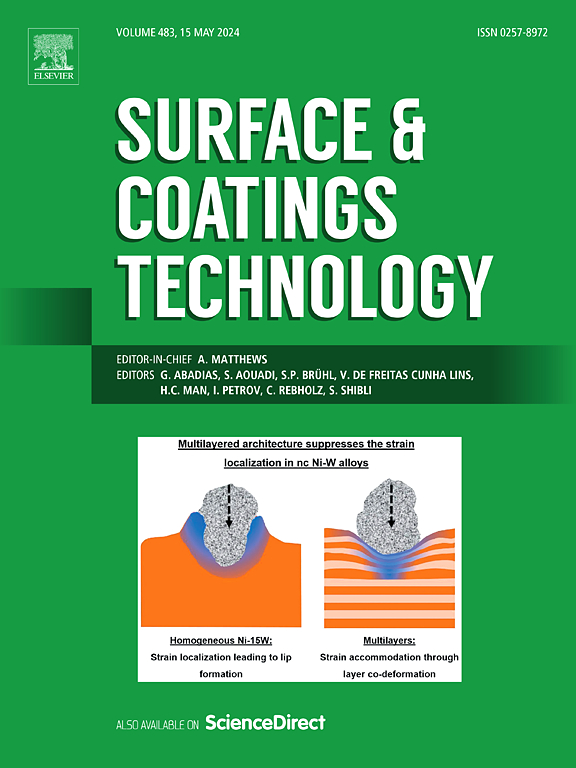在原位激光重熔处理的激光粉末床熔融(L-PBF)零件上沉积高速氧燃料(HVOF)涂层
IF 6.1
2区 材料科学
Q1 MATERIALS SCIENCE, COATINGS & FILMS
引用次数: 0
摘要
在这项工作中,我们重点研究了通过原位激光重熔处理来改变基材表面,从而增强高速氧燃料(HVOF)喷涂涂层与激光粉末床熔融(L-PBF)基材之间的附着力。此外,我们还研究了沉积在激光处理基底上是否会影响涂层的微观结构和性能。因此,在原位激光重熔处理下,在AISI 316l不锈钢基体上沉积了WC-10%Co-4%Cr涂层。在酸洗处理之前和之后,对所有基质进行涂覆。经喷砂处理的散装不锈钢样品作为参考。激光重熔改变了L-PBF表面的形貌,这取决于所使用的激光参数。最具能量的处理导致更宽间距的凹槽和熔化未熔化的球形颗粒附着在建成表面,导致更均匀的材料分布。这些变化影响了涂层的附着力。虽然所有拉伸试验失效主要是内聚,但经高能处理后沉积在基体上的涂层显示出增加的粘接-内聚强度,超过80 MPa,而所有其他样品的值都在70 MPa左右。然而,当基材进行重熔处理时,由于暴露于腐蚀剂穿透涂层缺陷的区域的基材腐蚀速度更快,涂层系统的耐腐蚀性下降。本文章由计算机程序翻译,如有差异,请以英文原文为准。
Deposition of high-velocity oxygen-fuel (HVOF) coatings on laser-powder bed fused (L-PBF) parts subjected to in-situ laser remelting treatments
In this work, we focused on enhancing the adhesion between High Velocity Oxygen-Fuel (HVOF) sprayed coatings and Laser-Powder Bed Fused (L-PBF) substrates by modifying the substrate surface through in-situ laser remelting treatments. Additionally, we investigated whether deposition on laser-treated substrates affected the coating microstructure and performance. Therefore, WC-10%Co-4%Cr coatings were deposited on AISI 316 L stainless steel substrates in as-built conditions and after two different in-situ laser remelting treatments. All substrates were coated both before and after a pickling treatment. Grit-blasted bulk stainless steel samples served as references.
Laser remelting changed the morphology of the L-PBF surfaces depending on the laser parameters used. The most energetic treatment resulted in more widely spaced grooves and melted the unmelted spherical particles attached to the as-built surface, leading to a more uniform material distribution. These changes influenced the adhesion-cohesion of the coatings. Although all tensile test failures were primarily cohesive, the coatings deposited on the substrates subjected to the most energetic treatment exhibited an increased adhesion-cohesion strength, exceeding 80 MPa, while all other samples showed values around 70 MPa.
When the substrate was subjected to remelting treatments, however, the corrosion resistance of the coated systems decreased due to faster substrate corrosion in areas exposed to corrosive agents penetrating through coating defects.
求助全文
通过发布文献求助,成功后即可免费获取论文全文。
去求助
来源期刊

Surface & Coatings Technology
工程技术-材料科学:膜
CiteScore
10.00
自引率
11.10%
发文量
921
审稿时长
19 days
期刊介绍:
Surface and Coatings Technology is an international archival journal publishing scientific papers on significant developments in surface and interface engineering to modify and improve the surface properties of materials for protection in demanding contact conditions or aggressive environments, or for enhanced functional performance. Contributions range from original scientific articles concerned with fundamental and applied aspects of research or direct applications of metallic, inorganic, organic and composite coatings, to invited reviews of current technology in specific areas. Papers submitted to this journal are expected to be in line with the following aspects in processes, and properties/performance:
A. Processes: Physical and chemical vapour deposition techniques, thermal and plasma spraying, surface modification by directed energy techniques such as ion, electron and laser beams, thermo-chemical treatment, wet chemical and electrochemical processes such as plating, sol-gel coating, anodization, plasma electrolytic oxidation, etc., but excluding painting.
B. Properties/performance: friction performance, wear resistance (e.g., abrasion, erosion, fretting, etc), corrosion and oxidation resistance, thermal protection, diffusion resistance, hydrophilicity/hydrophobicity, and properties relevant to smart materials behaviour and enhanced multifunctional performance for environmental, energy and medical applications, but excluding device aspects.
 求助内容:
求助内容: 应助结果提醒方式:
应助结果提醒方式:


